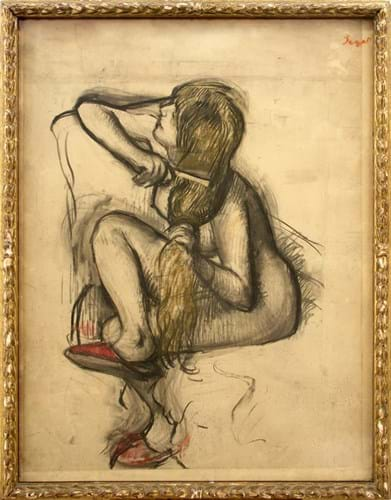
Femme se peignant (‘Woman combing her hair’) was previously owned by Gladys, Duchess of Marlborough, but was purchased at auction after her death in 1977 by collector Stephen Brod. Following his death, the recipient of the late owner’s estate, Claudia Rosencrantz, CEO of Jamie Oliver Media Group, chose Pallant House Gallery to receive the work in lieu of inheritance tax.
The study settled £490,000 in tax and the deal between the estate executors and the gallery was brokered by Sotheby’s.
“Remarkable Drawing”
The charcoal drawing with red chalk highlights dates from c.1887-1890 and was one of a series of studies that Degas created on tracing paper during this period. Similar examples can be found in the Musee d’Orsay in Paris, the Fogg Museum at Harvard in Massachusetts and the Museum of Fine Arts in Houston.
According to Pallant House Gallery’s artistic director Simon Martin, Femme se peignant also demonstrates the influence of Degas on British artists, in particular his friend Walter Sickert. “We are delighted by the acquisition of this remarkable drawing, which is a very significant enhancement to Pallant House Gallery’s permanent collection,” he said.
It will add to the gallery’s existing collection of continental works by Impressionist and Post-Impressionist artists including Paul Cézanne, Edouard Vuillard, Andrè Derain, Pablo Picasso and Gino Severini.
The work had a fascinating provenance. It remained with the artist for over a decade before it was acquired by dealer Ambrose Vollard who published it alongside several other large charcoal works in a celebratory volume of Degas’ work in 1914.
The drawing was then purchased by the socialite Gladys Deacon, a prolific but unconventional collector during the 1910s and 1920s, who was friends with artists and writers including Auguste Rodin and Marcel Proust. Deacon was famous for her beauty and is said to have captivated figures including Proust, Wilhelm Crown Prince of Russia, RC Trevelyan, Anatole France and Hermann von Keyserling.
As well as other works by Degas, she owned several sculptures by Rodin, and an oil painting by Toulouse-Lautrec. She also sat for Giovanni Boldini in 1901.
In 1921, Deacon became the Duchess of Marlborough after marrying the 9th Duke of Marlborough following his divorce from Consuelo Vanderbilt. She took residence at Blenheim Palace from which she was later evicted and died in a mental health institution in Northampton.
Signorelli Acquisition
The National Gallery in London has also recently acquired a work under the Acceptance-in-Lieu scheme.
Man on a Ladder by Luca Signorelli (c.1445-1523) depicts a figure descending with a pair of pliers after having removed the nails from the crucified Christ. An important Renaissance panel, it was originally part of a vast altarpiece depicting the Lamentation at the Foot of the Cross commissioned in 1504 for the church of Sant’Agostino in Matelica, a town in central Italy.

The panel by Luca Signorelli that has been acquired by The National Gallery in London under the Acceptance-in-Lieu scheme.
The large panel was subsequently cut into separate pieces for sale to different purchasers. Man on a Ladder is one of six known fragments of this altarpiece.
The others are currently housed in museums and collections around the world, including the Museo Civico, Bologna, the National Gallery of Art, Washington DC, and private collections in Genoa, Rome and England.
The first documented owner of Man on a Ladder was the arts patron and politician Sir William Graham who loaned the painting to the Pre-Raphaelite painter and designer Sir Edward Burne-Jones, who had a special interest in the works of Signorelli.
Caroline Campbell, the National Gallery’s curator of Italian Paintings before 1500 said: “Luca Signorelli is one of the most underappreciated artists of the Italian Renaissance. This muscular figure demonstrates the two qualities central to his work, his mastery of design and interest in the human form.”
Man on a Ladder can now be seen in Gallery 60 of the Sainsbury Wing hanging alongside other Signorelli paintings in the collection including The Adoration of the Shepherds and The Holy Family.





